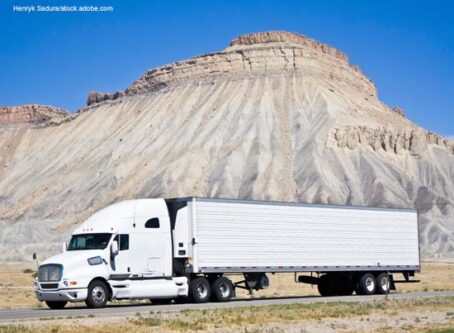Speed differential, limit changes considered in 10 states
Elected officials in states from Massachusetts to Oregon are looking into changes to speed limit rules. Legislators in multiple states are pursuing the elimination of speed limit differentials for cars and trucks, while legislation in a separate state would introduce differentials.
The Owner-Operator Independent Drivers Association says roadways are safest when all vehicles are permitted to travel at the same rate of speed. The Association does not advocate for a specific speed limit.
New Mexico
A Senate bill would introduce a speed limit differential for cars and trucks.
New Mexico now has 75 mph speed limits for all vehicles traveling on the state’s largest highways.
Sen. George Munoz, D-Gallup, is behind a bill to do away with uniform speeds. Specifically, SB359 would slow down trucks to 60 mph on affected roadways.
OOIDA says the bill would adversely impact the state’s motoring public and reduce highway safety.
Mike Matousek, OOIDA’s manager of government affairs, says that truckers are firsthand observers of the negative consequences of misguided traffic laws, including differential speed limits.
“OOIDA and our members are opposed to differential speed limits because they are counterproductive to safety, limit the ability of truck drivers to fully-control their vehicle, and negatively impact the behavior of other drivers and vehicle,” Matousek communicated to the bill sponsor.
“Ultimately, they create more interactions between cars and trucks, which leads to dangerous passing, aggressive driving, and an increase in the number of accidents.”
The bill is in the Senate Public Affairs Committee.
California
On the other hand, one legislators wants to do away with his state’s speed differential for cars and trucks.
Currently, smaller vehicles are allowed to drive 65 mph – 70 mph in certain locations – while large vehicles are limited to 55 mph.
Sponsored by Assemblyman Randy Voepel, R-Santee, AB172 would raise truck speed limits to 65 mph in rural areas.
“We’re excited that at least someone in the California Legislature is interested in addressing the state’s split speed limits for cars and trucks,” Matousek said. “We look at the current speed limit laws in California as a deterrent to highway safety.”
“They are also a contributing factor to increased congestion, carbon emissions, and increased inefficiencies with local, regional, and national goods movement.”
Indiana
A renewed effort in the Hoosier state would also do away with speed differentials.
Indiana law now permits cars to drive 70 mph while vehicles in excess of 26,000 pounds are limited to 65 mph.
Rep. Mike Aylesworth, R-Hebron, has introduced legislation in three of the past four legislative sessions to do away with the speed gap on rural stretches of interstates and the Indiana Toll Road.
His latest effort to permit trucks to travel 70 mph would affect an estimated 63,000 vehicles registered in the state and thousands more that access Indiana interstates on a daily basis.
If approved, the Indiana Department of Transportation has reported that 68 speed limit signs with the 65 mph restriction would need to be changed.
A fiscal impact statement attached to the bill, HB1092, notes that the expense to the state to change signs would be about $11,000. In addition, it is estimated the switch could result in fewer speeding citations.
The bill is in the House Roads and Transportation Committee.
Elsewhere, speed changes being pursed would apply to motorists and professional drivers.
Iowa
Faster speeds are under pursuit at the Iowa statehouse. One bill in the Senate Transportation Committee would bump speeds on interstate highways from 70 to 75 mph.
There are 17 states that authorize speeds of at least 75 mph. Only two of those states (Idaho and Montana) allow cars to travel one speed – 80 mph – while keeping trucks at a slower speed – 70 in Idaho and 65 mph in Montana.
Critics say that truck tires are not designed to handle speeds in excess of 75 mph. They point out that tire manufacturers say traveling faster than 75 mph can cause tires to blow out, creating safety issues.
Another point made is that many motor carriers set maximum speeds on commercial vehicles at 65 mph – to save fuel.
The Iowa bill is SF26.
Massachusetts
One Massachusetts bill is intended to benefit safety on the state’s roadways. The 14-page bill includes a provision that covers roadway work zones.
S7 would permit the Massachusetts DOT to set up temporary speed limits in work zones. Fines for speeding in affected areas would be doubled when workers are present.
The bill is in the Senate Transportation Committee.
Mississippi
Mississippi lawmakers could soon review a bill that covers large truck traffic during bad weather.
State law requires large trucks and buses to slow down to 45 mph on highways when visibility is reduced because of “inclement weather.”
Rep. Credell Calhoun, D-Hinds, again has introduced a bill to remove the requirement that visibility must be bad for affected drivers to slow down during snow, ice or rain storms.
OOIDA opposes the legislation.
Matousek previously communicated to Rep. Calhoun that the provision is problematic for multiple reasons.
“First, if inclement weather is present, all motor vehicles should decrease speed at a rate of travel that is safe; not just trucks,” Matousek wrote to the bill sponsor. “Second, (the provision) is overly vague and subject to interpretation by the law enforcement community.”
He adds that the bill would create more uncertainty for truckers operating in the state by requiring them to reduce speed to 45 mph during inclement weather, not just when visibility is bad.
“It also imposes a speed differential during conditions that might reduce the ability for a car to see a slower-moving truck, thus increasing the potential for accidents and further justifying the need for uniform speed limit laws.”
HB157 is in the House Transportation Committee.
Missouri
One Missouri state lawmaker hopes to bump up speeds on the state’s fastest roadways.
Rep. Ron Hicks, R-Dardenne Praire, has introduced a bill to raise speed limits from 70 to 75 mph for all vehicles on stretches of rural interstates and freeways.
Hicks’ bill, HB295, is in the House Transportation Committee.
North Dakota
The House Transportation Committee voted to advance a bill to increase speed limits for all drivers along certain highways.
State law now authorizes speeds of 75 mph on Interstates 29 and 94. Speeds along four-lane divided highways are set at 70 mph. Two-lane highways are posted at 65 mph.
Sponsored by Rep. Jake Blum, R-Grand Forks, HB1264 includes authorization for 80 mph on interstates. Speeds along four lane divided highways would be increased to 75 mph.
Blum says the change would allow for more efficient travel through the state. He adds that nearby South Dakota, Montana and Wyoming already permit 80 mph travel.
The North Dakota Department of Transportation estimates the change would result in expenses for the state totaling nearly $5 million. The agency cites costs for signage changes and roadway reconstruction.
The bill awaits further consideration in the House before it can come up for a floor vote.
Oklahoma
Multiple bills filed for consideration during the regular session that convenes Feb. 4 would amend rules on speed limits for the state’s turnpike system.
Oklahoma already permits all vehicles to travel at 75 mph on four-lane divided highways, including interstates. A 2016 state law, however, permits higher posted speeds after a state Department of Transportation engineering and traffic investigation.
Two bills, HB1071 and SB648 would set the speed on the turnpike system at 80 mph – up from 75.
In 2018, a similar bill was approved by the Senate, but it died in the House.
This year’s versions await assignment to committee for the regular session that began today.
Oregon
Two bills of note on the Oregon Legislature cover speed limits in certain areas.
One bill would permit changes in speed limits in the state’s largest city.
HB2702 would authorize the city of Portland to designate speed on the main arterials. Currently, only the Oregon DOT is permitted to make changes.
The second bill, SB397, would allow ODOT to set lower speeds on state highway in areas of eastern Oregon with populations below 40,000 people. The speeds could be changed without doing engineering and traffic investigations.
Local authorities must request the change.
The bills are in their respective chamber’s transportation committee.









